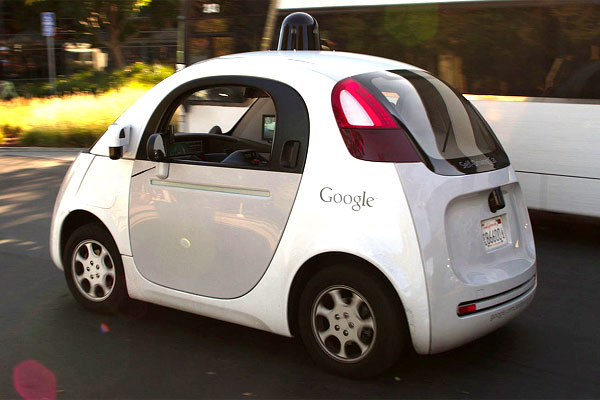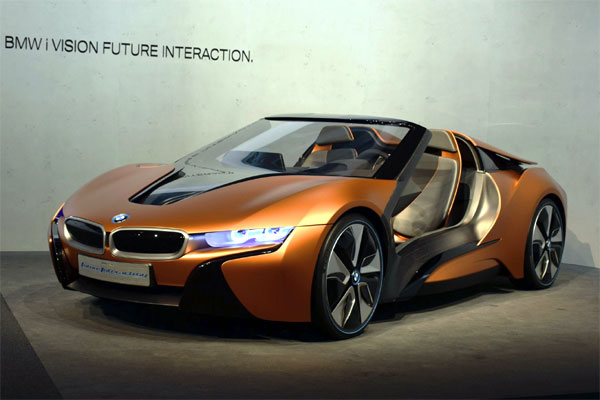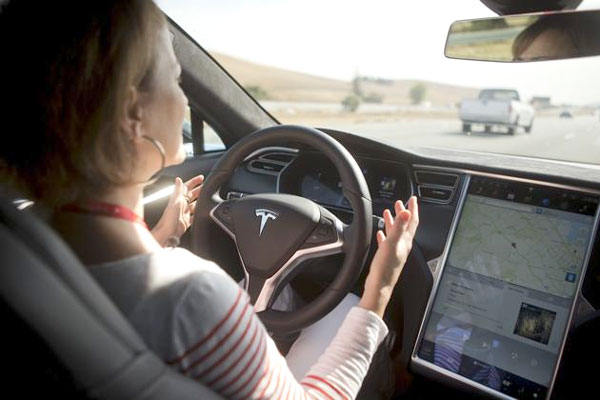by Rudolfo San Miguel
An autonomous car, sometimes called a self-driving car, is a vehicle that requires no driver. This car drives itself. The goal is far from being reached but several automakers are deep in developing this new concept in car technology.

By Michael Shick – Own work, CC BY-SA 4.0, https://commons.wikimedia.org/w/index.php?curid=44405988, Google Self Driving Vehicle in Mountain View, CA
Most notably in the U.S., General Motors has signed a partnership to design cars for Lyft to be used in their ride sharing service. GM is investing $500 million in the program and will also develop an autonomous version of the Chevy Volt.
Toyota debut their version of an autonomous car in 2013, but is still waiting for more research to be done. Meanwhile, Nissan announced a partnership with Renault, a French automobile company established in 1899, to design ten autonomous car models by 2020.
What About Car Insurance?
All of these automakers are on a search for the Holy Grail for a truly hands-free riding experience, one that will change everything for both road travelers and car insurers. A report was issued by KPMG—one of the “Big Four” in international professional services that offer auditing, assurance, tax, consulting, advisory, and so forth—detailing how car insurance will be affected by a possible 80% drop in accidents by 2040. But what about in the next 10 to 15 years?
“Insurance companies need to understand how these new capabilities affect driving risk, “said Joe Schneider, a representative with KPMG. He went on to say that “It’s like a baby, going from crawling to walking to running.” What Joe Schneider is talking about is the question of how any insurer can estimate the risk in an autonomous car unless they can understand the level of autonomy offered by the vehicle.
This is where the National Highway Traffic Safety Administration (NHTSA) has gotten involved. They defined five different levels of autonomy for self-driving cars. According to a representative from the NHTSA, autonomous cars are “an area of rapid change, which requires the DOT and NHTSA to remain flexible and adaptable as new information and technologies emerge. Amid that rapid change, the North Star for DOT and NHTSA remains safety.”
The concept of safety is important to keep in mind. It is why insurers are probably very interested in what NHTSA has to say. The fear of a car malfunctioning and causing an accident may be a major problem with building these vehicles. When a computer stops working correctly important data, time, or money could be lost. What happens when a self-driving car stops doing its job right?
Five Levels Autonomy in Autonomous Cars
With this in mind, the importance for defining these five levels for autonomous cars becomes extremely self-evident. Here is what you should know about these levels:
Level 0
This is basically a regular car with no autonomous functionality. The driver controls all operations of the vehicle.
Level 1
This is would be a semi-autonomous self-driving car. What this means is that some functions can be done by the car; however, the driver is mostly in charge.
There is a lot that can be offered at this level. Think about a car that can automatically turn on headlights when it senses the sun is setting or when you are entering a tunnel. How about a car that turns on the AC when the cabin gets too cold and turns off when a certain temperature is reached, just like in a home AC system. At this level, there could be cars that could automatically alert you when it senses that you may be falling asleep at the wheel. You could also have cars that could activate certain safety procedures if you lose control or spin out.
Level 2
At this level a driver can take their hands off the wheel. It is also is the level where two functions in a car must be automated. This level still leaves the driver in control of the vehicle and monitoring its performance while in operation; however, it allows for the car to handle more than one function without the manipulation of the driver. How would this be useful you may ask?
Consider commuting in heavy traffic where you really have to focus your attention on both what is happening on the road and how you are controlling the car. At this level, your vehicle could both handle air conditioning and headlights for instance. It could both provide assistance with speed management and offer assistance with breaking.
Level 3
Under this level, drivers can hand over control of their vehicle during certain conditions of either traffic congestion or environmental factors. The Society of Automotive Engineers (SAE) define this level as “the driving mode-specific performance by an automated driving system of all aspects of the dynamic driving task with the expectation that the human driver will respond appropriately to a request to intervene.”
Level 4
At this level, a car becomes fully autonomous. The car can perform safety critical functionality and monitor conditions on the road during the whole driving period.
This brings to mind a whole new level of “cruise control.” Think about a 100% car version of Autopilot, way beyond what is currently offered through Tesla’s new feature. Here is a scenario:
You start your car and drive towards the freeway for a short road trip. After navigating onto the freeway and into the open road, you let your car take control while you call your girlfriend who has already arrived at your destination. You discuss plans for the next several days, while your car takes care of your driving. You take control of your vehicle after your conversation and pull over at an exit to refuel. Now, you’re back on the road and release control to your car. But this doesn’t last long because it seems someone lost some cargo they were hauling. Their debris is all over the road. You decide to take back control again so you navigate around all the stuff on the road. Soon, you are clear of the debris field and allow the car to take over driving once again. You call your girlfriend and let her know you’re going to be a little late.
This is what can happen at level 4. This is what Tesla promises will be available in 2018.
Level 5
At this level, the car is fully autonomous. The driver isn’t even present at this level. There are only passengers or riders. To put it another way, at this level your car has passed all its driving exams and has its own driver’s license—figuratively speaking. Here is another example:
You’re at your aunt’s house with your girlfriend. She asked to use your car, and you agree. She gets in your vehicle and reads a magazine while your car chauffeurs her to her destination. She leaves the car there. Later in the day when you’re about leave your aunt’s place, you pull out your phone and order your car to meet you there. In less than an hour, your car shows up, and you’re taken home by your vehicle. Jokingly, you might consider seeing your aunt there watching you leave, shaking her head and praying for your safety.
The Future

Munich, Germany – March 16th, 2016: Presentation of a super car BMW i Vision Future Interaction. This prototype demonstrates how will be look the new cars from BMW in future.
There has been talk about making other vehicles autonomous. By taking the idea that is popular with private automobiles and creating other sources of transportation and allowing them to use this technology. There has been some discussion about autonomous trucks. Specifically, there has been talk about automating some of the processes that a trucker must perform, like hitching a tractor to a trailer or backing into a cargo dock.
In the bigger picture, could it be possible someday that truck drivers become obsolete and shipping companies retain a fleet of self-driving trucks? Probably not as it is hard to imagine a driverless truck pulling into a gas station to refuel; however, many functions handled by these drivers may someday be autonomous of a human controller.
The same could be said about our nation’s railroads for both passengers and cargo. Trains run on tracks so there is less need for an operator. Maybe trains of the future will have crews onboard solely to oversee operations the train is performing and monitor the train’s performance to avoid disasters.
As mentioned earlier in this article, GM is partnering with Lyft, a ride sharing service, to build a fleet of cars for passenger transport services. Could this mean the complete elimination of taxies for this driverless option? In this vision, will ride-sharing disappear as well?
What about planes and helicopters? Could there be a point in the distant future where these vehicles are able to operate safely without pilots? And construction and farming tractors, could they function without operators? Could they start performing designated tasks and make decisions about their job?
There is so much to consider about this technology and where it may lead that volumes of books could written on the topic. There are probably already being published. The truth is that only the future will reveal to us how this technology will be used.
Tesla’s Autopilot update
Tesla did something amazing in October 2015. They wirelessly updated every U.S. Tesla built and sold in the past year. The overnight update itself was extremely remarkable. It was the first of its kind. Tesla updated these car’s infotainment systems like an app developer would update their app on your smart phone. In one simple update, Tesla took the concept of the connected car to the next level.
Among the features Tesla added in the update was Autopilot, which mimics some of the characteristics of another revolutionary idea in automaking: Autonomous cars. Autopilot enables drivers to temporarily allow their car to handle basic driving functions, similar to what autonomous cars can accomplish.
Tesla is moving in the right direction with the Autopilot update. Though Tesla doesn’t offer Level 4+ autonomy in their cars, it does offer the closest thing to it. Specifically, the option in Autopilot called “Autosteer.” This feature reads highway lane lines and detects other vehicles. It does this by harnessing a series of sensors built into applicable Tesla models, which include front-facing radar, a camera that uses image recognition, and a 360-degree ultrasonic sonar emitter. This allows these Tesla models to steer themselves and maintain safe driving speeds. These features will not allow for a fully autonomous car, but create an option for drivers to let their car take the wheel with proper supervision.
Here is the thing. Consider the big news concerning this release of Autopilot. It was downloaded by Tesla wirelessly, similar to when you are receiving app updates on your phone. The connected car updating innovation that Tesla has created can be used for further updates, allowing Autopilot to be further refined without the car owner having to do anything.
Additionally, through the owner’s consent, information from these car models can be relayed back to Tesla developers. This information can include data on highways, freeways, and other roads. It can include data on driving conditions during different weather events, road environments, traffic patterns, and so forth. This allows Tesla to create a car driven crowdsourcing database of information that it can use to refine and expand their ventures into autonomous car technology.
In this sense, we can start to see how these ideas of connected cars, autonomous vehicles, infotainment systems, and GPS navigation systems start to blend into one another. This is why search engine giants like Google can enter into the car world and mobile ride sharing services like Lyft can partner with automaking giants like GM.
Only time and the spark of innovative thinking fueled by imagination can tell where this road will lead, or who will be driving.
Here some sources of further reading:
- http://www.techrepublic.com/article/autonomous-driving-levels-0-to-5-understanding-the-differences/
- http://www.techrepublic.com/article/ces-2016-carmakers-kick-off-the-year-with-big-moves-in-autonomous-vehicles/
- http://www.techrepublic.com/article/self-driving-trucks-what-needs-to-happen-before-they-change-product-shipping/
- http://www.wired.com/2015/10/tesla-self-driving-over-air-update-live/
- http://www.theverge.com/2016/1/10/10746020/elon-musk-tesla-autonomous-driving-predictions-summon
- http://fortune.com/2015/12/21/elon-musk-interview/
About author: Rudolfo San Miguel is an independent writer for GROM Audio.
GROM Audio is the developer of connected car and vehicle infotainment solutions, including Bluetooth, Android, iPhone and USB car kits for factory stereos.


